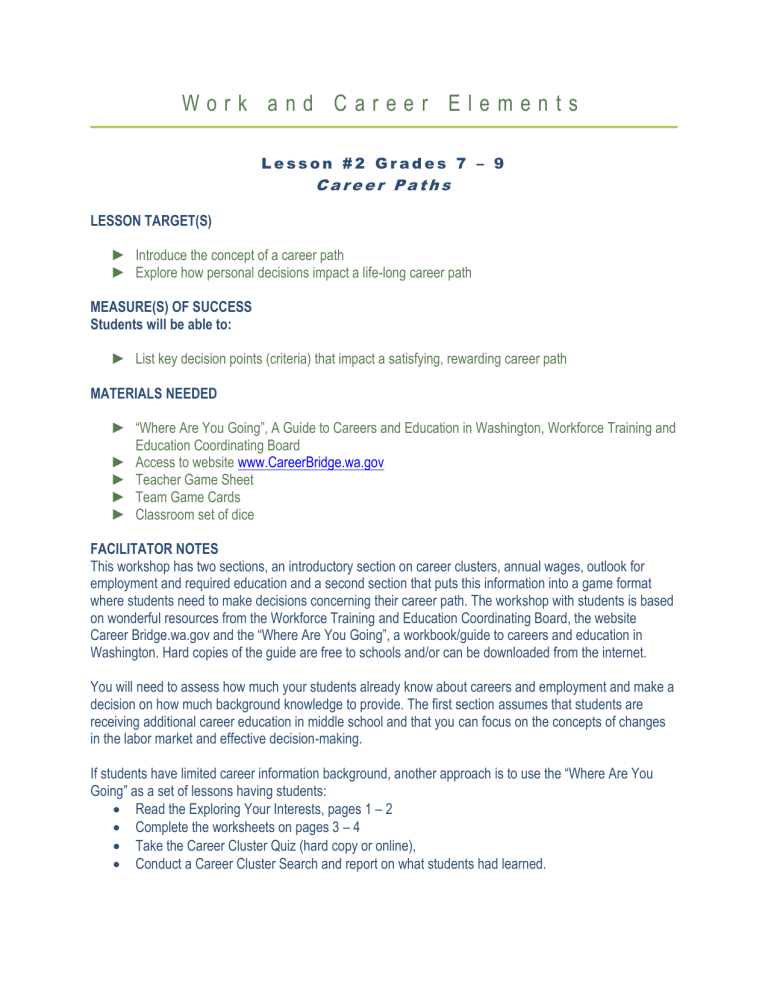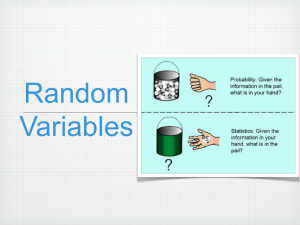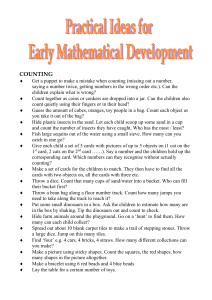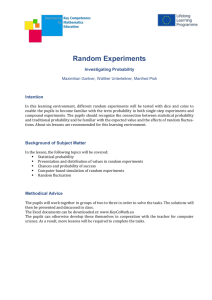Career Ready Lesson 2 Grades 6

W o r k a n d C a r e e r E l e m e n t s
L e s s o n # 2 G r a d e s 7 – 9
C a r e e r P a t h s
LESSON TARGET(S)
► Introduce the concept of a career path
► Explore how personal decisions impact a life-long career path
MEASURE(S) OF SUCCESS
Students will be able to:
► List key decision points (criteria) that impact a satisfying, rewarding career path
MATERIALS NEEDED
► “Where Are You Going”, A Guide to Careers and Education in Washington, Workforce Training and
Education Coordinating Board
► Access to website www.CareerBridge.wa.gov
► Teacher Game Sheet
► Team Game Cards
► Classroom set of dice
FACILITATOR NOTES
This workshop has two sections, an introductory section on career clusters, annual wages, outlook for employment and required education and a second section that puts this information into a game format where students need to make decisions concerning their career path. The workshop with students is based on wonderful resources from the Workforce Training and Education Coordinating Board, the website
Career Bridge.wa.gov and the “Where Are You Going”, a workbook/guide to careers and education in
Washington. Hard copies of the guide are free to schools and/or can be downloaded from the internet.
You will need to assess how much your students already know about careers and employment and make a decision on how much background knowledge to provide. The first section assumes that students are receiving additional career education in middle school and that you can focus on the concepts of changes in the labor market and effective decision-making.
If students have limited career information background, another approach is to use the “Where Are You
Going” as a set of lessons having students:
Read the Exploring Your Interests, pages 1 – 2
Complete the worksheets on pages 3 – 4
Take the Career Cluster Quiz (hard copy or online),
Conduct a Career Cluster Search and report on what students had learned.
It is also possible to conduct student research on the website CareerBridge.wa.gov encouraging students to complete the online quiz, review job trends, and consider the education levels needed.
CORE ACTIVITY
Introduction
Share with students that today’s workshop (or possible the next two class periods) are going to focus on a
“career path”. Remind students that an occupation is a series of jobs and a career is the lifetime of making good use of your skills, knowledge and experiences.
Activity – Part 1
1.
Ask students to think about what questions they need to ask themselves in order to choose a job, an occupational area or make decisions on a career path. Record student answers first but be sure to encourage them to include such questions as: a.
How well will the job/occupation match your interests? b.
How much education is needed at the entry level? c.
How much will you earn at the beginning of a job? d.
How much will you earn on average? e.
How much will you earn in a lifetime? f.
What kinds of skills, knowledge and expertise will you need in order to change jobs within the occupation? g.
How many people are presently employed in this job? h.
Is there a prediction jobs in this area will grow and how many openings are there presently in Washington State?
2.
Using the “Where Are You Going” Career Clusters share with students a comparison of jobs that: a.
Have different annual wages, b.
Require different levels of education, c.
Have varying levels of employment outlook.
3.
Discuss the decisions people make as they plan for careers and answer student questions.
Activity – Part 1
1.
Explain to students that they are now going to apply what they learned in a game setting. Share that the purpose of the game is to have the smoothest possible career path and the fewest
number of points.
2.
Put students in teams of four. Each team should be in the same career cluster. You can allow teams to choose clusters or jobs or assign them from the “Where Are You Going”. Hand out team game cards, individual worksheets and dice.
3.
Ask students to individually identify an entry job they to use to start their career path and put that on their team card.
4.
See Teacher Worksheet for game rules.
5.
Game continues until all questions are asked and points tallied. Ask each to report out their points and the biggest surprise!
Closing
Revisit the decisions made on the career pathway. What ones would they change? What ones seem most important? If possible, give students time to sketch out their career plan and discuss their ideas.
8
9
10
1
2
3
4
5
6
7
Teacher Instruction Game Sheet: Career Pathways
Introduction
Career Pathways highlights some of the important decisions or turning points students may experience in their career pathway. The game/activity is not intended to predict a students’ future but to give them an idea of how a career develops. To give a realistic view of what can happen, all decisions in Career Pathways
(like life) are left to chance (rolling of the dice).
How You “Win”
The teams with the fewest number of points have had the smoothest “career path”, presumably making the best decisions in life and winning the game.
How the game is played
Note: You can allow groups to play independently or you can complete each of the six sections as a class.
1.
Each student rolls a die determining their individual points. Have students record their points on the team “game” sheet.
2.
Each student checks the indicator box on their individual worksheet that matches their throw number.
3.
Students within teams are expected to talk about the decisions each student made and to help each other during the game so be sure to give teams enough time for discussion.
4.
Continue in a similar fashion until all six sections are completed.
5.
Total up both the individual and the team points.
6.
The team(s) with the lowest points “win”. Discuss how making different decisions made have made a difference in making the career pathway smoother.
Data for the game: Media Income
January 1, 2013 through December 31, 2013
Number in Family Median Income (Monthly)
3580
4682
5784
6885
7987
9088
9295
9502
9708
9915
Team Game Sheet: Career Pathways
Occupational Area or Career Cluster Assigned:
Student B. Student C.
Entry Job Chosen
Career Interest
Points
Student A.
Experience Points
Education Required
Points
Student D.
Median Income
Points
Income Growth
Points
Job Openings
Total Individual
Points
Total Team Points:
If this were real life not controlled by the throw of dice, what decisions could team members have made to help them have a smoother career pathway and “win” the game? Record your ideas and be prepared to share.
Individual Game Sheet: Career Pathways
Career Path Indicators
Points per
Throw
Career Interests
1 – 2 You choose an entry career that matches several of your interests.
3 – 4 You choose an entry level career that sort of matches your career interests.
5 - 6 The entry level career you choose doesn’t really matches your interests. It is something others think you should do.
Points per throw
Career Experiences
1 – 2 You already have lots of volunteer or work experience that is similar to your entry position.
3 – 4 You have some volunteer or work experience that is similar to the entry level job you chose.
5 - 6 You have no volunteer or work experience that matches your entry level job.
Points per
Education Required throw
1 – 2 You choose your courses carefully in high school and college. You have the education required for your first job in this occupational field.
3 – 4 You have some courses that match the requirements for the entry level position. You may need to get more training.
5 - 6 You are not anywhere close to meeting the education requirements of the job. Add three points to your dice throw because you do not have a career or educational plan.
Points per throw
Median Income
1 – 2 The annual salary for the entry level position is below the state median wage for one person but you know this is only a starting place. Your plan education plan will help you move up quickly to other higher paying jobs in this occupational area (career cluster).
3 – 4 The entry level position you choose looks like it has a great entry salary but you have a lot of personal debt and this may not cover all of your bills.
5 - 6 You are disappointed in the entry level salary. You thought you would be making enough money have a fancy apartment, new car and everything!
Check
Your
Points
Check
Your
Points
Check
Your
Points
Check
Your
Points
Points per throw
Income Growth
1 – 2 The difference between the entry wage and the average wage is large enough that you will be able to feel financially ok.
3 – 4 The difference between the entry wage and the average wage Isn’t very large and you are concerned about the increasing bills
5 - 6 You are really disappointed in the difference between the entry wage and the average wage. You are beginning to think perhaps you chose the wrong job and maybe even the wrong occupation.
Points Job Openings per throw
1 – 2 This is either a job where there is solid growth and openings or your educational plan will allow you to apply for a job with better growth in the near future.
3 – 4 This is a job that seems to be growing but will decline in the future or already has a slow growth factor. You need to begin to think your education/career plan.
5 - 6 You are about to be unemployed because there is little or no growth in your career field and without an educational plan you can not apply for any other jobs.
Check
Your
Points
Check
Your
Points









